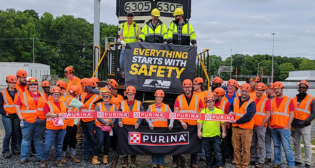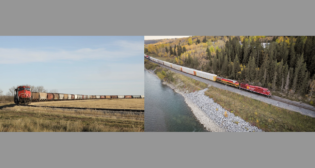
Keeping rolling stock rolling
Written by AdministratorHow Union Pacific achieved a record 8.6-day car cycle time. For many years, freight car shortages plagued the railroad industry.
Terminal congestion was a major problem. In the just-published third volume of his acclaimed history of the Union Pacific, Maury Klein tells the following story of one of the frequent crises that confronted John Kenefick as he presided over the reconfiguration of UP in the late 20th Century:
“Choke points existed not only on the line but even more terminals, where under congested conditions trains fell into a coma. One educated guess of a freight car’s average cycle found that 73% of its travel time was spent in terminals, including 39% in intermediate terminals. A mere 11% of its time went to actual train movement. These numbers, observed Railway Age, ‘would send a motor carrier into gales of laughter even as he carved out chunk after chunk of the railroads’ traffic.’” (RA, May 1986, p. 2.)
Fast forward to 2011. Union Pacific announces that in the year just passed it achieved an average freight car cycle time of 8.6 days, the best in its history. How? For one thing, the comatose yard is history. Little more than 24 hours now elapses from the time a car enters a classification yard until it leaves on a new train for its destination. (That’s not an “educated guess.” Dwell time in yards is one of the performance metrics now required weekly by the Surface Transportation Board.)
To get a broader picture of how “America’s Greatest Railroad” (Maury Klein’s description) tackles equipment productivity issues, Railway Age talked last month with UP Executive Vice President-Operations Lance Fritz. We asked him the following questions:
• What ongoing programs do you have to improve freight car utilization?
• Where is there still room for the most improvement? Will it be possible to improve on last year’s car cycle time of 8.6 days?
• How important are the following in improving productivity: Preventive maintenance? Scheduled railroading? Average train speed? Yard dwell time? Car capacity? Fault detection? Distributed power?
• How many turns do your intermodal cars get per year? Boxcars? Other?
• What improvements would you like to see in car components?
• To what degree do you use contract car repair services?
• What improvements would you like to see in your car repair shops?
• What can your customers do to improve car turnaround times?
• How many cars do you currently have in storage? How many of these would you describe as serviceable?
“Improving freight car productivity contributes to reduced inventory, increased network velocity, and overall operating efficiency and helps Union Pacific deliver value for our customers,” Fritz told Railway Age. “Union Pacific’s freight car productivity improved 23% from 2004 to 2010.
“We focus on the entire freight car cycle by designing our network for lowest possible empty return miles, reducing on-line work events, increasing train velocity, reducing the amount of time customers keep cars at origin and destination points, and reducing car dwell in terminals.
“We increased our freight car investments to improve overall fleet quality. These investments help us manage our business with fewer cars, leading to less congestion and better velocity, ultimately increasing the value proposition Union Pacific delivers to customers.
“The majority of a freight car’s cycle time is spent on trains or in yards, so our continuous improvement efforts systematically work to improve velocity and reduce dwell time.
“Train speed is the cornerstone of freight car utilization. Maintaining train speed and reducing the variability that saps speed are critical in consistently meeting customer expectations.
“Distributed power technology is helping us increase train sizes across all our businesses, helping us improve network fluidity by reducing the overall number of train starts, and contributing to our 18% velocity improvement since 2008.
“Running a disciplined, scheduled railroad enhances freight car utilization as it reduces variability and enhances reliability, allowing the team to focus on process improvement and eliminating waste. It is also vital to operate through and recover from operational challenges that nature can throw at us, like the Midwestern floods we are battling this summer. Preventive maintenance is important, but predictive maintenance leads to greater overall efficiency because we can address multiple items while the car is in the shop and therefore make that freight car available to customers for longer periods of uninterrupted time.
“Yard dwell time is a critical piece of the overall utilization picture and is a direct indicator of network fluidity.
“Car capacity increases in specific car types reduce overall car inventory requirements which, in turn, also support network fluidity.
“While we don’t publish the number of turns we make with our cars, our continuous improvement process helps us identify ways to increase turns while we remain focused on overall safety, service, and efficiency.
“We would like to see continued improvement in the quality and durability of moving parts that the customers handle on a regular basis, such as gates and hatches on covered hoppers and doors on box cars. We also would like components to have the same or similar life spans so they fail at about the same time. We work with equipment OEMs to improve the safety, functionality, and reliability of every major freight car type, an effort called ‘The Car of the Future.’
“We prefer to use our own shops to maintain consistent levels of quality and processes, and better manage costs.
“We will continue to be aggressive in our approach to improving all aspects of Union Pacific operations, including improvements in shop safety, productivity, and efficiency—with an ultimate goal of being an incident-free work place.
“Our job is to ship our customers’ products safely and efficiently. We work with our customers to improve all the processes that go into delivering the best transportation solution for each customer, including improving freight car cycles.
“We work together with our customers to improve supply chain productivity, which includes load and unload processes, the number of cars required to support their business requirements, and managing inbound shipment volumes. Ordering more cars than required idles cars that could be used elsewhere, reducing overall network efficiency. We also work with customers to help them minimize the number of surplus private rail cars stored in Union Pacific rail yards. Fewer cars stored in our yards means less congestion and increased velocity.
“We had approximately 27,000 rail cars in storage through early June, with approximately 75% of them serviceable.”
CN: Grain gains
CN has also realized significant gains in freight car productivity. President and CEO Claude Mongeau, speaking to the Winnipeg Chamber of Commerce in February, cited CN’s Scheduled Grain Plan (introduced in 2010) as “an example of innovation that is driving significant gains for all stakeholders in the grain industry.”
“CN’s success under this plan in delivering specified hopper cars to specified elevators on specified days each week has translated into more predictable service to the grain industry,” Mongeau said. “Grain companies can now better schedule their staff at country elevators and waterfront export terminals. It’s all about selling the right grain at the right time to the right buyer and ultimately creating more wealth for Canadian farmers.”
CN says it achieved a fulfillment rate of more than 85% for spotting of covered hoppers on the day the railway committed their placement during 2010. The Scheduled Grain Plan is “a prototype of what we have to do more of in the key supply chains we serve to support increased competitiveness,” Mongeau noted. “This business model will require greater collaboration from all players and a renewed willingness to innovate in order to stake our ground in world markets. Achieving greater grain supply chain efficiencies means the system needs to evolve from one that’s too often characterized by adversarial relationships to one based on closer collaboration and a clear end-to-end supply chain perspective. This is best achieved in a context of mutual trust and in a commercial framework.”
More Canadian efficiencies
Transport Canada recently outlined several environmental initiatives that are also improving freight car productivity.
“The maximum allowable axle load has been increased from 263,000 pounds to 286,000 pounds on many lines in Canada. Thus, the gross-to-tare ratio of such freight cars is increased, permitting the railroads to reduce the number of railcars without losing capacity. The quantity of gross ton-miles accumulated to move a given amount of freight is thus reduced. The railroads have invested in aluminum cars to improve tare-to-gross weight ratios and have also reduced railcar rolling friction through the use of steerable-axle trucks and the universal use of roller bearings on running gear.
“Doublestack container cars permit a higher container cargo volume for a specific train length, thus lowering the fuel consumption and emissions. However, on intermodal trains, attention is required to avoid unfilled slots, that is, cars without containers. Analyses have shown that improving slot utilization from 90% to 100% reduced the aerodynamic resistance coefficient sufficient to save fuel.
“Longer trains: Trains up to 1.5 miles in length are now operating as a result of lengthened passing tracks and sidings. Longer trains permit improved utilization of locomotive power.
“Distributed power: Distributing a remote-controlled locomotive within a freight train permits better handling of long trains, especially in undulating terrain, so as to provide more optimum locomotive power assignment.
“Consolidation of cars with similar destination into blocks: This operational tactic reduces delays at intermediate locations and increases fluidity at rail yards and terminals. The reduction of delays reduces fuel consumption and emissions.
“Train pacing and braking strategies: Pacing is the use of better track/train management by network management personnel to ensure trains are not rushing to meets. Also, where operations permit, coasting to a stop rather than using heavy braking requiring engine power is being opted more and more. Effectively all main line locomotives are now fitted with dynamic brake equipment. This allows the use of the dynamic brake to control train speed variations rather than the use of the air brake system. As the latter does not allow the locomotive engineer to reduce the severity of a brake application already in force, it is frequently necessary to apply power at the same time as the brakes to maintain speed over variable track grades. This causes a significant increase in fuel consumption. When the dynamic brake is used to control speed, the severity of the application can be varied at will and the fuel consumption is reduced.
(Editor William C. Vantuono contributed to this story.)



